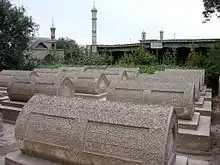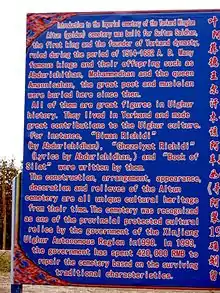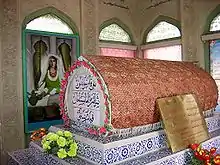Abdurashid Khan
Abdurashid Khan (Uighur: عبد الرشيد خان) was the ruler of the Yarkent Khanate in modern-day Yarkant County, Xinjiang between 1533 and 1560.
| Abdurashid Khan | |
|---|---|
| Khan of Yarkent Khanate | |
| Reign | 1533 – 1560 |
| Predecessor | Sultan Said Khan |
| Successor | Abdul Karim Khan |
| Born | 1508 |
| Died | 1560 |
Biography
Abdurashid Khan was a descendant of the first Moghul Khan Tughluk Timur Khan (1347-1363) and was born in 1508. He came to power in 1533 when his father and predecessor Sultan Said Khan died of altitude sickness during a military expedition in the region of Kashmir.[1]
One of Abdul Rasid Khan's wives was Amannisa Khan. She is credited with collecting and thereby preserving the Twelve Muqam, which is today considered a musical style of the Uyghur people of northwest China. The Muqam of Xinjiang has been designated by UNESCO as part of the Intangible Heritage of Humanity.
In 1538, Abdurashid Khan concluded a treaty with Uzbek Chief Ubaydullah Sultan, who ruled the Khanate of Bukhara at the time (1533–1539). He also completed a similar treaty with the Moghul Empire in India. During the negotiations with Ubaydullah Sultan, a Naqshbandi Sufi teacher Ahmad Kasani (1462–1542), known as Makhdum-i ' Azam (the Great Master) came to Kashgar from Samarkand and was granted land there. His descendants, known as Makhdum Zadas and bearing title "Khoja", played an important role in the history of Xinjiang during the 16th to 19th centuries.
The descendants of Makhdum's eldest son Muhammad Amin (died in 1598), or Ishan Kalan, the founder of the Ishkiyya branch of the Sufi order (tariqa) Naqshbandi khojagan, established themselves in Kashgar and became known as the Aq Taghliks, those of the Tian Shan (or "White Mountains"). The descendants of his second son, Ishaq Wali (died in 1599), founder of branch Ishakiyya of the Sufi order Naqshbandi khojagan, established themselves in Yarkand and became known as the Kara Taghliks, those of the "Black Mountains", i.e. the Pamirs, Karakorum and Kunlun.
Abdurashid Khan featured stature of the body and strength of hands. He had no equal in shooting with a bow and also was a talented musician, he wrote a music Shirashangiz which was very popular in the Yarkand Khanate. He also completely learned 12 Mukams, classical Uyghur music. He liked to change his clothes, following Khalif Harun al-Rashid, and wander among the population without recognition. He made three trips to Khotan in such clothes and he died here during his last trip.
After his death in 1560, Abdurashid Khan was succeeded in Yarkand by his second son Abdul Karim Khan (Yarkand) (ruled 1560–1591).
Between 1541 and 1546, the historian and ruler of Kashmir on behalf of Babur's descendants, Mirza Muhammad Haidar Dughlat, wrote the book "Tarih-i-Rashidi" (The history of Rashid). He devoted it to Abdurashid Khan, despite the fact that he himself was expelled by the Khan with many of his relatives from Kashgaria. It had been under the rule of his ancestors, the Dughlat Amirs, for about 300 years (1219–1514), beginning with Dughlat Amir Babdaghan (Tarkhan), who was granted the country "Mangalai Suyah" (Faced to Sun) by Chagatai Khan, second son of Chengiz Khan.
Royal Cemetery of Yarkand Khanate

Next to Sultan Said Khan are buried here Abdurashid Khan, Abdul Karim Khan, Muhammad Khan, Ahmed Khan, Abdul Latif Khan and their descendants, as well as the Muqam (Mukam) -teacher, poet and musician Aman Isa Khan (1526-1560, the wife of the second ruler Abdurashid Khan)


Genealogy of Chaghatai Khanate
In Babr Nama written by Babur, Page 19, Chapter 1; described genealogy of his maternal grandfather Yunas Khan as:
"Yunas Khan descended from Chaghatal Khan, the second son of Chlngiz Khan (as follows,) Yunas Khan, son of Wais Khan, son of Sher-'ali Aughldn, son of Muhammad Khan, son of Khizr Khwaja Khan, son of Tughluq-timur Khan, son of Aisan-bugha Khan, son of Dawa Khan, son of Baraq Khan, son of Yesuntawa Khan, son of Muatukan, son of Chaghatal Khan, son of Chingiz Khan"
Research project by Dr Abdul Rauf Mughal
Chughtai Khanate (Kashgaria)
| Preceded by Sultan Said Khan |
Yarkent Khanate 1533–1560 |
Succeeded by Abdul Karim Khan |
References
- Bellew, Henry Walter (1875). "Kashmir and Kashghar. A narrative of the journey of the embassy to Kashghar in 1873-74". Internet Archive. London: Trubner & Co, Ludgate Hill. p. 96. Retrieved 2 January 2020.
Sultan Said suffered so severely from difficulty of breathing in the passage of the highliands--on which he subsequently died
- The Babur Nama in English, Zahiru'd-din Mubammad Babur Padshah Ghdzt, ANNETTE SUSANNAH BEVERIDGE